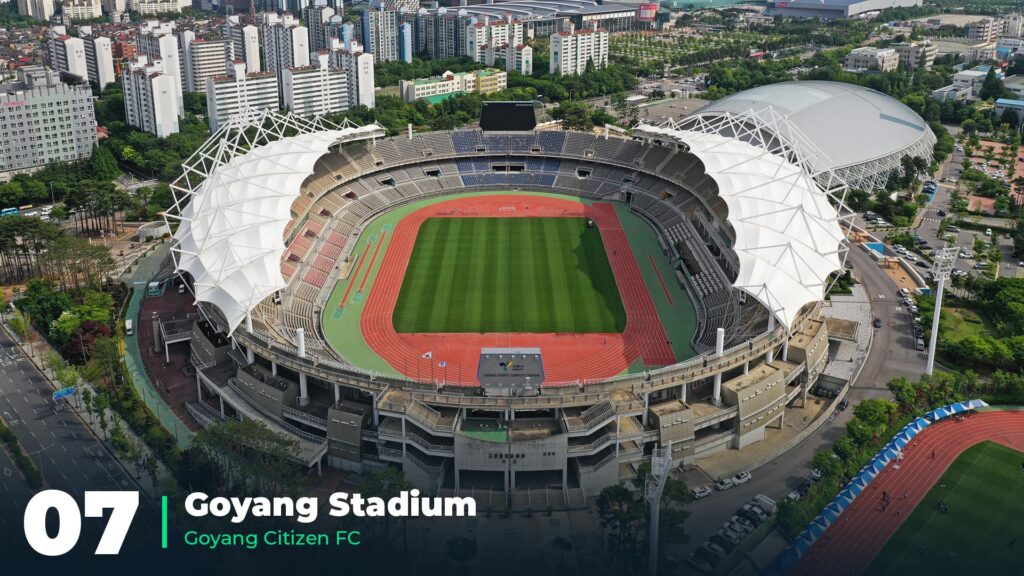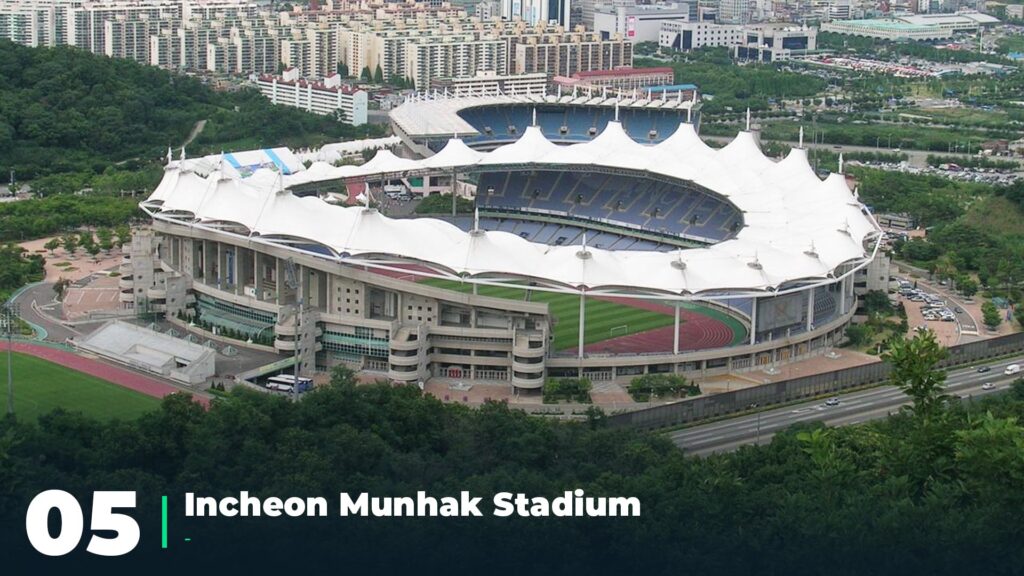
These are of the top 10 football stadiums in South Korea, and there are many more smaller stadiums and facilities used for lower division and amateur football matches throughout the country.

10 Ulsan Munsu Football Stadium
Capacity: 37,897 | Location: Seo-gu, Gwangju, South Korea
Located in a major industrial city, the Ulsan Munsu football Stadium contains both mechanical and environment-friendly imagery. The overall shape of the stadium is in the shape of skull crown that symbolizes Silla and Bangudae Petroglyphs.
The venue hosted several 2002 FIFA World Cup matches.

09 Gwangju World Cup Stadium
Capacity: 40,245 | Location: Gwangju, South Korea
To honour the former South Korean national team coach Guus Hiddink, who helped the team advance to the semi-finals, for the first time in its history, by defeating Spain in this stadium, they have also named it the Guus Hiddink Stadium
It is the home stadium of Gwangju FC of the Korea Professional Football League (K League)

08 Daejeon World Cup Stadium
Capacity: 40,535 | Location: Daejeon, South Korea
It was used to host some matches at the 2002 FIFA World Cup hosted by South Korea and Japan. The stadium displayed a sophisticated structural dynamism, eliminating decorative decoration
After the World Cup, the stadium was planned to be a multi-purpose sports park.

07 Goyang Stadium
Capacity: 41,311 | Location: Goyang, South Korea
The Goyang Stadium is a multi-purpose stadium in Goyang, South Korea. It is used mostly for football matches and was the home ground of Goyang Zaicro FC of the K League Challenge between 2013 and 2016.
The stadium holds 41,311 people and was built in 2003. It is occasionally used for the South Korea national football team matches

06 Suwon World Cup Stadium
Capacity: 44,031 | Location: Suwon, South Korea
Completed in 2001, the Suwon World Cup Stadium lies approximately four kilometres north of downtown Suwon. Upon its construction it hosted games at the 2001 FIFA Confederations Cup, just as it did the following year for the FIFA World Cup.
K-League side Suwon Samsung Bluewings FC currently play their home games there.

05 Incheon Munhak Stadium
Capacity: 49,084 | Location: Incheon, South Korea
Incheon Munhak Stadium or also known as Incheon World Cup Stadium is a multi-purpose stadium in Munhak Sports Complex in Incheon City. Built in preparation for the 2002 FIFA World Cup and also the main stadium for the 2014 Incheon Asian Games, this stadium now hosts various events all year round.
Inside the stadium, there are several convenient stores and a variety of fast-food restaurants for you to enjoy during your event.

04Busan Asiad Main Stadium
Capacity: 53,769 | Location: Busan, South Korea
Busan Asiad Main Stadium is a multipurpose sports complex that provides sports events and performances. The stadium is uniquely designed with curves and has 48 pillars and 72 exits, with minimal walls for an open space feel. The stadium was the first sports arena in Korea to be recognized as a first-class international stadium by the International Association of Athletics Federations (IAAF).
A lighting system of 2000 lux and the splendid electronic scoreboard provide spectators with high-resolution TV relay broadcasting for an exciting game watch.

03Daegu Stadium
Capacity: 66,442 | Location: Daegeu, South Korea
Busan Asiad Main Stadium is a multipurpose sports complex that provides sports events and performances. The stadium is uniquely designed with curves and has 48 pillars and 72 exits, with minimal walls for an open space feel. The stadium was the first sports arena in Korea to be recognized as a first-class international stadium by the International Association of Athletics Federations (IAAF).
A lighting system of 2000 lux and the splendid electronic scoreboard provide spectators with high-resolution TV relay broadcasting for an exciting game watch.

02Seoul World Cup Stadium
Capacity: 66,704 | Location: Seoul, South Korea
Seoul World Cup Stadium has two large digital panels on the south and north part of the stadium that are 25 meters in width and 9.2 meters in height. The panels provide detailed visual for the spectators as well as provide information such as temperature, humidity, wind speed and more.
The LED screen has a 16:9 ratio and delivers clear images to the spectators.

01Seoul World Cup Stadium
Capacity: 69,950 | Location: Seoul, South Korea
Situated in Jamsil-dong, the Seoul Sports Complex was completed in December 1976. Seoul Olympic Stadium, the centerpiece of the Seoul Sports Complex (also called Jamsil Sports Complex) is surrounded by a housing complex for athletes, Jamsil Apartment Complex, the Hangang River, and Tancheon Stream. Olympic Park is located 3.5 kilometers southeast from the stadium.
Seoul Olympic Stadium has hosted some of the biggest global sporting events including the 10th Asian Games and the Seoul Olympic Games. Naturally, it has attracted millions of tourists for its significance.














